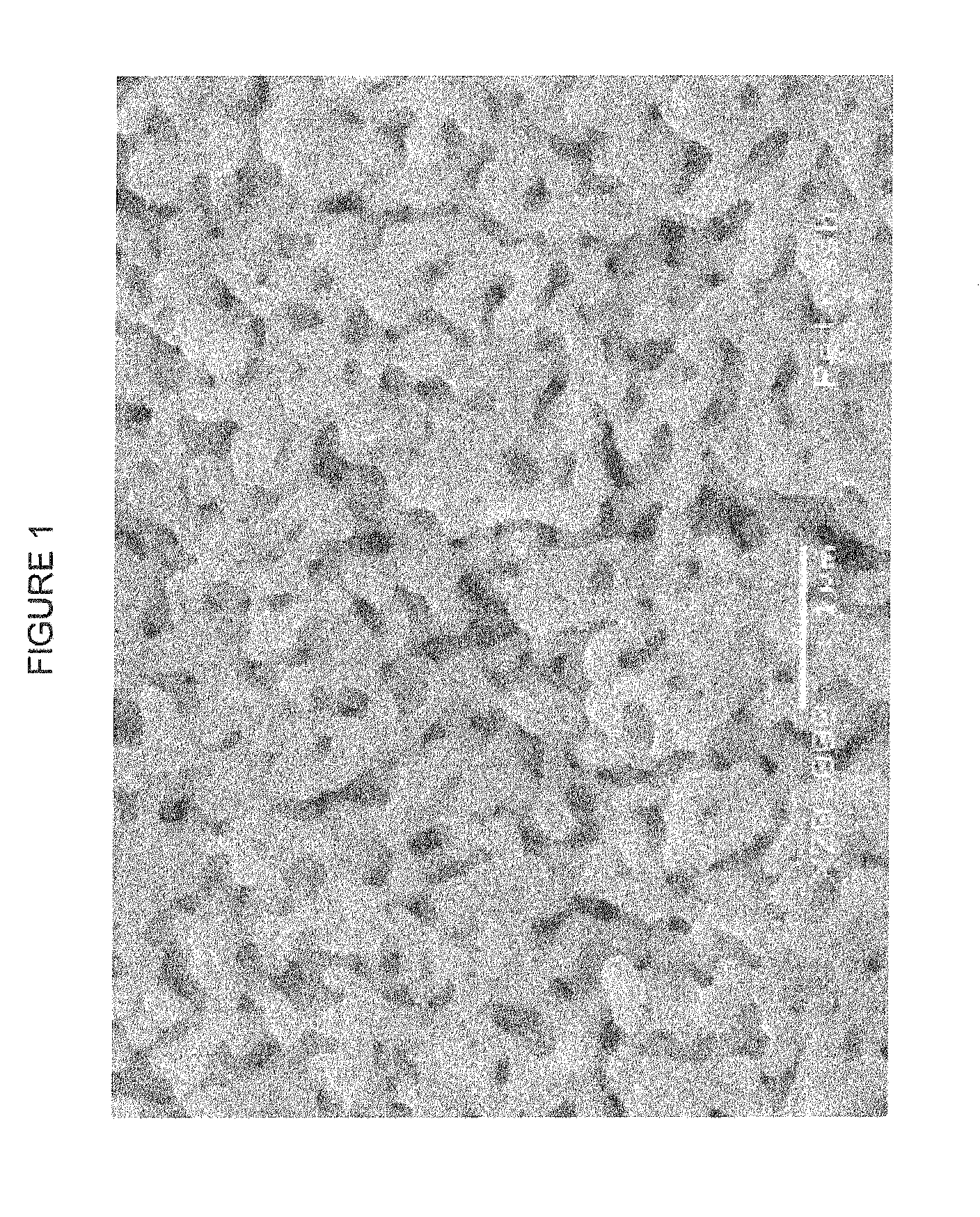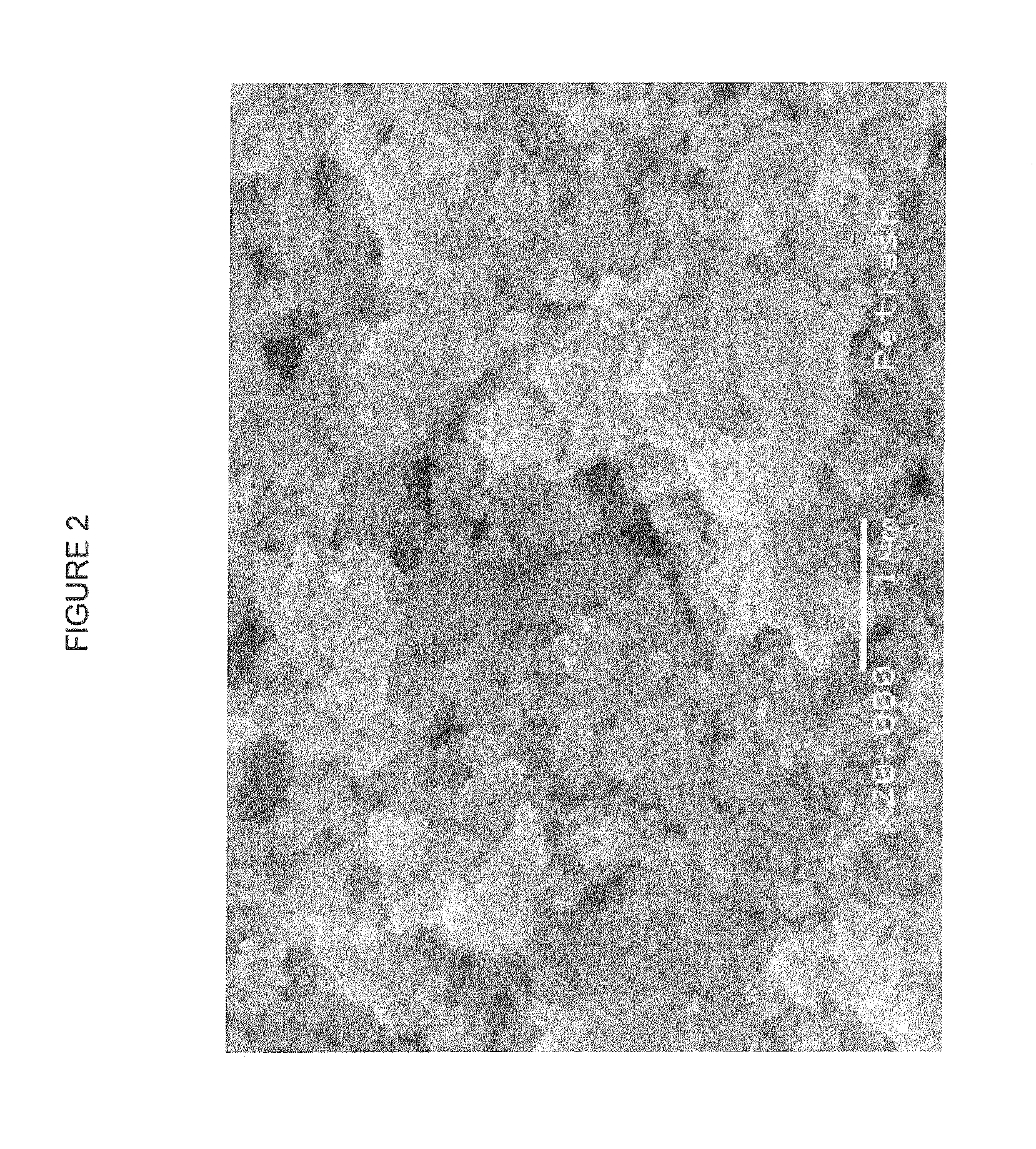Conductive material and process
a technology of conductive materials and processes, applied in the field of preparing conductive ink compositions and conductive networks, can solve the problems of limited conductivity obtainable from micron scale silver flakes, difficult synthetic routes, and inability to tolerate temperatures in this range for most substrates, other than ceramics or metals, to achieve the effect of enhancing adhesion to substrates
- Summary
- Abstract
- Description
- Claims
- Application Information
AI Technical Summary
Benefits of technology
Problems solved by technology
Method used
Image
Examples
example 1
Formulation of Conductive Ink
[0043]Silver oxalate was prepared from silver nitrate and oxalic acid dihydrate in aqueous solution. Oxalic acid dehydrate, 30 g, was dissolved in 350 ml water. Separately, silver nitrate, 30 g, was dissolved in 120 ml water. The silver nitrate solution was added to the oxalic acid solution dropwise with stirring, causing a white precipitation of silver oxalate to immediately appear. When the reaction was completed, the solution was filtered using 1 μm filter paper to isolate the precipitate. The isolated precipitate was washed with water twice to remove the soluble components and residual acid; then further washed with ethanol twice.
[0044]The isolated silver oxalate, 25 g, was added to 50 g of ethanol, and formed a suspension. The suspension was continuously stirred and cooled in an ice bath. Then 50 g of isopropanolamine was added to the suspension dropwise over ten minutes. Octylamine, 12.5 g, was added, at which point the silver oxalate started disso...
example 2
Evaluation of Conductivity and Adhesion
[0046]To evaluate the conductivity of the ink from Example 1, a glass slide (25×25 mm) was dipped into a pool of the ink until coated with the ink. Immediately the coated slide was placed on a hot plate held at a temperature between 120° to 130° C. for 30 minutes until the silver oxalate decomposed and silver nanoparticles formed. (The silver nanoparticles were not deposited in any pattern; when dipped into the pool of ink, they instead formed a coating or film of nanoparticles. In commercial applications, the inks would have been deposited in predetermined patterns to form conductive traces.)
[0047]The resistance of the ink was measured with a 302 Resistivity Stand from Lucas Labs, which uses a standard four-wire probe. The geometric dimensions of the films were measured with a standard ruler. The film thickness was measured with a white light interferometer, WyKo NT3300 Interferometer from Veeco.
[0048]The results of eight samples of the compos...
example 3
Comparative Ink from Pre-Made Silver Nanoparticles
[0052]Nanosilver paste (product R7000-95 from Ferro Corporation) was diluted with carbitol so that the silver concentration was 20% by weight. Polyvinylpyrrolidone (PVP) was added to the solution to bring the concentration of PVP to 2% by weight, creating a ratio between silver and PVP of 10 to 1. The solution was thoroughly mixed at 3000 rpm for 30 seconds (SPEEDMIXER, Houschild, Model DAC150SP).
[0053]The nanoparticle ink was coated onto a silicon wafer by spin-coating and annealed at 120° C. or 130° C. for 30 minutes. The resistance of the ink was measured with four-point probe. After this first resistance measurement, the films were exposed to pulse UV and then the resistance was measured again. The samples and results are listed in Table 3. The films became conductive after heating, but further exposure to UV pulses did not decrease the resistance significantly. The level of resistance obtained is an order of magnitude greater th...
PUM
| Property | Measurement | Unit |
|---|---|---|
| temperature | aaaaa | aaaaa |
| temperatures | aaaaa | aaaaa |
| temperatures | aaaaa | aaaaa |
Abstract
Description
Claims
Application Information
 Login to View More
Login to View More - R&D
- Intellectual Property
- Life Sciences
- Materials
- Tech Scout
- Unparalleled Data Quality
- Higher Quality Content
- 60% Fewer Hallucinations
Browse by: Latest US Patents, China's latest patents, Technical Efficacy Thesaurus, Application Domain, Technology Topic, Popular Technical Reports.
© 2025 PatSnap. All rights reserved.Legal|Privacy policy|Modern Slavery Act Transparency Statement|Sitemap|About US| Contact US: help@patsnap.com



